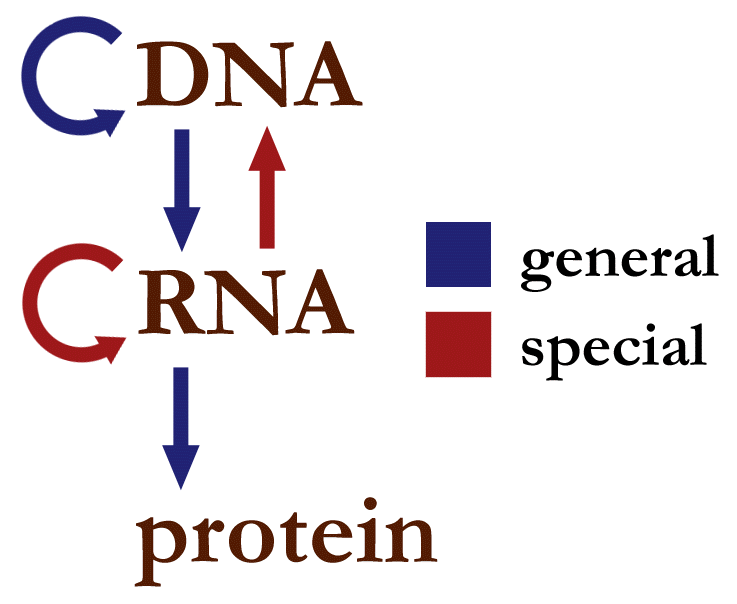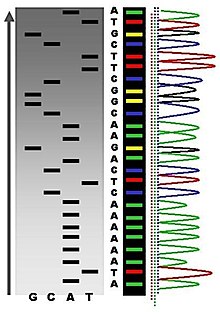 |
| Picture source: Wikimedia
The central dogma of biology is a fundamental concept in molecular biology that describes the flow of genetic information from DNA to RNA to proteins. According to the central dogma, DNA contains the genetic information that is used to produce proteins, which carry out most of the functions in a cell.
However, there are some exceptions to the central dogma. One of the main exceptions is the process of reverse transcription, which is the synthesis of DNA from an RNA template. This process occurs in some viruses, such as HIV, and in some eukaryotic cells during the process of gene expression.
Another exception to the central dogma is the process of RNA editing, which is the modification of RNA molecules after they are transcribed from DNA. RNA editing can involve the addition or deletion of nucleotides, or the substitution of one nucleotide for another. This process can change the sequence of the RNA molecule and, as a result, the protein that it encodes.
Another exception to the central dogma is the process of RNA interference (RNAi), which is a mechanism that cells use to regulate gene expression. RNAi involves the degradation of specific RNA molecules by enzymes called RNases. This process can prevent the production of proteins that are encoded by the degraded RNA, which can have important effects on cell function.
While the central dogma of biology is a fundamental concept in molecular biology, there are some exceptions to this rule. Understanding these exceptions can provide important insights into the complex processes that occur within cells.
|
Top 10 cool fun facts about bacteria
1. Bacteria outnumber your cells
The human body contains more bacterial cells than human cells. In fact, it is estimated that there are 10 times as many bacterial cells in the human body as there are human cells. These bacteria help perform important bodily functions, such as aiding digestion and supporting the immune system.
2. You are carrying three pounds of bacteria
The average person carries around 3 pounds of bacteria in their body. This bacteria is found in different body parts, such as the skin, mouth, and digestive system. While some of these bacteria are beneficial, others can cause disease.
3. That accidental discovery saved many lives
Alexander Fleming discovered the first antibiotic, penicillin by accident in 1928. Fleming was studying the growth of bacteria when he noticed that a mold had contaminated one of his culture plates. The mold produced a substance that killed the bacteria, and Fleming isolated this substance and named it penicillin.
4. Smoll bacteria, apparently called Mycoplasma genitalium
The smallest known bacteria is Mycoplasma genitalium, which is just 0.3 micrometers in size. This is about 1/10 the size of a red blood cell, making it one of the smallest known organisms in the world. Despite its small size, it can still cause infection in humans.
5. They are good guys
Bacteria can help break down food and create important nutrients for the human body. Some bacteria, such as those found in the human gut, can break down complex carbohydrates and create short-chain fatty acids that are used by the body for energy. These bacteria can also help produce vitamins, such as B and K, essential for good health.
6. A sprinkle of history, shall we?
The term “germ” was coined in the 19th century to describe the microorganisms that cause disease. Before this time, microorganisms were known as “animacules” or “little animals”. The term “germ” was originally used to describe the seeds of disease, but it was later applied to all microorganisms that cause illness.
7. 10,000 different species. Just to put it in perspective, every human being is a member of one species.
There are over 10,000 different species of bacteria. These species are found in various environments, from the human body to soil and water. Some bacteria are beneficial to humans, while others can cause disease.
8. Harsh weather? What is that?
Bacteria can survive in extreme environments, such as boiling water, freezing temperatures, and even radioactive waste. This is because bacteria have evolved to adapt to their environment and can survive in conditions that would be lethal to other organisms.
9. Germs being bros
The human mouth contains over 700 different types of bacteria. These bacteria break down food and create byproducts that can lead to tooth decay and gum disease. It is important to maintain good oral hygiene to keep these bacteria under control.
10. I mean, gotta reproduce, no?
Bacteria can reproduce incredibly quickly, with some species doubling in number every 20 minutes. This rapid reproduction allows bacteria to quickly spread and colonize new areas. It also makes it difficult to control bacterial infections, as the bacteria can quickly adapt to new environments and develop resistance to antibiotics.
How to survive finals week? Stress management tips
 |
| Picture source: Wikimedia |
Finals week is approaching. Professors are wrapping their courses as we are almost done with the Fall semester. Being focused during exams can be a challenge, especially if you are feeling stressed or overwhelmed. However, it is important to stay focused in order to perform well and achieve your goals. Here are some tips to help you stay focused during exams:
- Get enough sleep. Sleep is essential for concentration and memory, so make sure to get enough rest the night before an exam. Aim for 7-9 hours of sleep per night.
- Eat well. Eating a balanced diet can help improve your concentration and focus. Avoid sugary snacks and drinks, which can give you a temporary energy boost but can lead to a crash later on. Instead, opt for healthy snacks like fruits, nuts, and whole grains.
- Stay hydrated. Drinking plenty of water can help keep your mind and body functioning properly. Keep a water bottle with you during the exam so you can stay hydrated.
- Avoid distractions. Turn off your phone and any other electronic devices that may distract you during the exam. If you are easily distracted by noise, consider wearing earplugs or finding a quiet place to take the exam.
- Take breaks. It can be helpful to take short breaks during the exam to give your mind a rest and recharge. Stand up, stretch, and take a few deep breaths to help clear your head and refocus.
- Use effective study techniques. Prior to the exam, be sure to study using techniques that are proven to be effective for learning and retention. This may include creating study guides, making flashcards, or using mnemonic devices.
- Stay positive. It is normal to feel anxious or stressed before an exam, but try to stay positive and focus on the task at hand. Remind yourself that you have studied and prepared, and trust in your abilities.
- Seek help if needed. If you are struggling to focus or are feeling overwhelmed, don’t hesitate to seek help from a teacher, counselor, or tutor. They can provide support and advice to help you succeed.
The key is here to love yourself and make sure to take care of your mind and body. You can do it. Love.
What is serial dilution method in microbiology?
Serial dilution is a technique used to reduce the concentration of a substance in a sample. It is commonly used in microbiology to determine the number of bacteria in a given sample, as well as to isolate and identify bacterial strains.
The process of serial dilution involves mixing a known volume of a sample with a known volume of a diluent, such as water or saline. This mixture is then transferred to a new container and mixed with an equal volume of diluent. This process is repeated multiple times, resulting in a series of progressively more dilute samples.
For example, if a sample contains 100 bacteria and is mixed with 10 ml of diluent, the resulting mixture will have a concentration of 10 bacteria per ml. If this mixture is then mixed with 10 ml of diluent, the resulting mixture will have a concentration of 1 bacteria per ml. This process can be repeated multiple times to create a series of progressively more dilute samples.
The number of bacteria in each dilution can be determined by plating a known volume of the dilution onto a Petri dish containing agar, a solid growth medium. The agar is incubated at a suitable temperature and conditions for the bacteria to grow and form colonies. The number of colonies that form on the agar can then be counted and used to calculate the number of bacteria in the original sample.
Serial dilution is a valuable tool in microbiology because it allows researchers to determine the concentration of bacteria in a sample, even if the sample contains a large number of bacteria. It is also useful for isolating and identifying bacterial strains, as different bacterial strains will form distinct colonies on the agar.
Additionally, serial dilution is used in the laboratory to determine the minimum inhibitory concentration (MIC) of an antimicrobial agent. The MIC is the lowest concentration of the agent that is able to inhibit the growth of bacteria. By performing a series of serial dilutions with the antimicrobial agent, researchers can determine the MIC and evaluate the effectiveness of the agent against different bacterial strains.
What Is The Difference Between Molecular Biology And Molecular Genetics
Molecular biology and molecular genetics are closely related fields of study that focus on the structure, function, and behavior of molecules within living organisms. Molecular biology is a broad field that encompasses many different sub-disciplines, including molecular genetics. Molecular genetics is a sub-discipline of molecular biology that focuses specifically on the role of genes and how they are expressed and inherited within living organisms. In other words, molecular genetics is a more specialized field within molecular biology that focuses on the genetic makeup of cells and how genes are passed down from one generation to the next.
Central Dogma of Biology
 |
| Picture source: Wikimedia |
The central dogma of molecular biology is a term coined by Francis Crick to describe the flow of genetic information in living organisms. This flow of information is essential for the functioning of all cells, and is the basis for many of the fundamental processes of life, such as growth, development, and reproduction.
The central dogma of molecular biology states that genetic information flows from DNA to RNA to protein. This process begins with the transcription of DNA into RNA, which is carried out by enzymes called RNA polymerases. RNA polymerases bind to specific sequences in the DNA called promoters, and then use the DNA as a template to synthesize an RNA molecule that is complementary to the DNA.
This RNA molecule, also known as messenger RNA (mRNA), is then used as a template for the synthesis of a protein molecule. This process, known as translation, is carried out by ribosomes, which are cellular structures that are responsible for protein synthesis. The ribosome reads the sequence of nucleotides in the mRNA, and uses this information to synthesize a protein molecule with a specific sequence of amino acids.
The flow of genetic information from DNA to RNA to protein is essential for the functioning of all cells. DNA contains the genetic information that is required for the synthesis of all of the proteins that are necessary for life. The process of transcription and translation allows cells to produce the proteins that they need in order to carry out their functions.
The central dogma of molecular biology has been supported by a wealth of experimental evidence, and it is considered to be one of the fundamental principles of molecular biology. It has also been extended and refined over time to include additional details about the process of gene expression, such as the role of regulatory elements and the mechanisms by which genes are turned on and off.
In addition to its importance in molecular biology, the central dogma has also had a significant impact on other fields of science, such as medicine and biotechnology. For example, the ability to manipulate the flow of genetic information has led to the development of powerful new tools for studying and treating genetic diseases, as well as for producing valuable proteins and other biomolecules for use in research and industry.
The central dogma of molecular biology is a key concept that helps to explain how genetic information is used and transmitted in living organisms. It is a fundamental principle that has had a profound impact on our understanding of the basic processes of life, and continues to be an important area of research in the field of molecular biology.
What are common molecular biology techniques
 |
| Sanger sequencing |
Molecular biology deals with the structure and function of macromolecules, such as nucleic acids and proteins, which are essential to life. Molecular biology techniques are a set of tools and methods used by scientists to study and manipulate the structure and function of these macromolecules. Some common molecular biology techniques including:
- Polymerase chain reaction (PCR): This is a technique used to amplify a specific DNA sequence in order to make large amounts of a particular DNA fragment for further analysis. This is done by using special enzymes called polymerases to synthesize new strands of DNA complementary to the target sequence.
- Gel electrophoresis: This is a technique used to separate DNA or protein molecules based on their size and charge. A sample of DNA or protein is placed in a gel matrix, and an electric current is applied to the gel. The molecules migrate through the gel, and the smaller molecules move faster than, the larger ones, allowing them to be separated into distinct bands.
- DNA sequencing: This is a technique used to determine the order of the nucleotides in a DNA molecule. This is done by using special enzymes to break the DNA molecule into smaller fragments and then using dideoxynucleotides, which are nucleotides that can terminate DNA synthesis, to create a series of DNA fragments of known length. These fragments are then separated by gel electrophoresis, and the order of the nucleotides is determined by comparing the sequences of the fragments.
- Western blotting: This is a technique used to detect specific proteins in a sample. The sample is first separated by gel electrophoresis, and then the proteins are transferred from the gel to a membrane. The membrane is then incubated with antibodies that specifically bind to the target protein, and the presence of the protein is detected using a special detection method.
- Cloning: This is a technique used to create multiple copies of a specific DNA sequence. This is done by inserting the DNA sequence into a vector, such as a plasmid, which is then introduced into a host cell, such as a bacterial cell. The host cell replicates the vector and the inserted DNA sequence, producing multiple copies of the DNA.
These are just a few examples of the many molecular biology techniques that are used in research. These techniques have greatly advanced our understanding of the structure and function of macromolecules and have contributed to many important discoveries and advances in the fields of biology and medicine.
What is Molecular Biology
Evolution of life on Earth
 |
| Picture source: Wikimedia |
The evolution of life on Earth is a complex and fascinating process that has been ongoing for billions of years. It is thought to have begun with the formation of the first simple cells capable of self-replication and metabolism. Over time, these cells evolved and diversified, giving rise to the wide variety of life that we see today.
How does qPCR work?
Quantitative polymerase chain reaction (qPCR) is a molecular biology technique that is used to amplify and measure the amount of a specific DNA or RNA sequence in a sample. It is a highly sensitive and specific method that can be used to detect and quantify the amount of a specific sequence in a sample, even when it is present at very low levels.
| Picture source: Wikimedia |
qPCR is based on the same principles as PCR (polymerase chain reaction), but it includes additional steps that allow for the quantitative measurement of the amplified DNA or RNA. In qPCR, a sample of DNA or RNA is first amplified using PCR. During the amplification process, specific fluorescent dyes or probes are added to the reaction mixture, which bind to the amplified DNA or RNA. As the amplification proceeds, the amount of fluorescent signal produced increases in proportion to the amount of amplified DNA or RNA.
After the amplification is complete, the qPCR machine measures the amount of fluorescence produced during the reaction. This allows the researcher to determine the amount of the specific DNA or RNA sequence present in the sample. Because the amount of fluorescence produced is directly proportional to the amount of amplified DNA or RNA, qPCR can be used to accurately measure the amount of a specific sequence in a sample, even when it is present at very low levels.
qPCR is an important molecular biology technique that allows researchers to quickly and accurately measure the amount of a specific DNA or RNA sequence in a sample, providing valuable insights into the molecular mechanisms of diseases and other biological processes.






